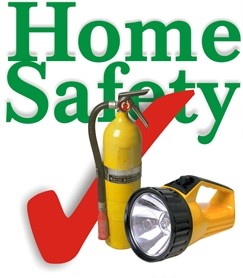Home Safety Checklist To Child Proof The Home

About 70 percent of children who die from unintentional household injuries are 4 years old and younger, according to KidsHealth.org. Child-proofing a home before a newborn arrives and as the child progresses in age and ability can prevent many of these injuries from occurring. A parent needs to consider everything from keeping breakable objects out of childrens' reach to securing furniture.
Outlets
Electrical outlets carry the risk of electrocution if a baby or toddler decides to approach it with a metal object or another object out of curiosity. Outlet protection can come in two forms: plates and covers. Outlet plates overlay the entire outlet area and either lock or are otherwise difficult for children to open. Constructed of sturdy plastic, an electrical outlet cover inserts or plugs into the outlet itself.
Cabinets and Drawers
Small children can pry open cabinets and drawers. Kitchen cabinets and drawers often contain sharp knives and other cooking instruments; bathroom drawers and cabinets may contain poisonous cleaning detergents and medications that can be lethal if ingested by children. To secure these spaces, install child-proof cabinet and drawer latches and locks. Safety-locking devices usually feature a small latch or button that needs pressed in a manner that would prove difficult for children to accomplish.
Stairs
Stairs pose a safety risk to both small infants that crawl and toddlers old enough to walk down the stairs. Safety gates can be installed to walls and nearby hallways or areas leading up to the stairs. These devices prevent accidental falls down the stairs and can also block access to rooms and off-limits areas you don't want your children to reach. Stairs need to be re-assessed for toddlers' sakes. For example, secure loose railings and install carpet or stair padding to soften falls in case accidents occur.
Furniture
Television stands and nightstands, coffee tables, bookcases and dressers all pose dangers to children. For example, children often use furniture to pull themselves up into a walking position; some furniture can topple over when this occurs, crushing a child. Some furniture, such as bookcases, television stands and dressers, can be steadied by being anchored to the floor or wall with furniture straps. Corner and edge bumpers easily install on the ends or corners of furniture that may have sharp edges, such as glass-top tables or coffee tables and entertainment stands that have wooden corners.
Water Temperature
Extremely hot water can cause scalding and third-degree burns on small children, if not monitored or controlled. The U.S. Consumer Product Safety Commission recommends installing anti-scald devices on faucets and shower heads as well as adjusting the hot water heater to 120 degrees Fahrenheit. Anti-scald devices help reduce the likelihood of burns by responding to temperature and/or pressure changes in the water.
Outlets
Electrical outlets carry the risk of electrocution if a baby or toddler decides to approach it with a metal object or another object out of curiosity. Outlet protection can come in two forms: plates and covers. Outlet plates overlay the entire outlet area and either lock or are otherwise difficult for children to open. Constructed of sturdy plastic, an electrical outlet cover inserts or plugs into the outlet itself.
Cabinets and Drawers
Small children can pry open cabinets and drawers. Kitchen cabinets and drawers often contain sharp knives and other cooking instruments; bathroom drawers and cabinets may contain poisonous cleaning detergents and medications that can be lethal if ingested by children. To secure these spaces, install child-proof cabinet and drawer latches and locks. Safety-locking devices usually feature a small latch or button that needs pressed in a manner that would prove difficult for children to accomplish.
Stairs
Stairs pose a safety risk to both small infants that crawl and toddlers old enough to walk down the stairs. Safety gates can be installed to walls and nearby hallways or areas leading up to the stairs. These devices prevent accidental falls down the stairs and can also block access to rooms and off-limits areas you don't want your children to reach. Stairs need to be re-assessed for toddlers' sakes. For example, secure loose railings and install carpet or stair padding to soften falls in case accidents occur.
Furniture
Television stands and nightstands, coffee tables, bookcases and dressers all pose dangers to children. For example, children often use furniture to pull themselves up into a walking position; some furniture can topple over when this occurs, crushing a child. Some furniture, such as bookcases, television stands and dressers, can be steadied by being anchored to the floor or wall with furniture straps. Corner and edge bumpers easily install on the ends or corners of furniture that may have sharp edges, such as glass-top tables or coffee tables and entertainment stands that have wooden corners.
Water Temperature
Extremely hot water can cause scalding and third-degree burns on small children, if not monitored or controlled. The U.S. Consumer Product Safety Commission recommends installing anti-scald devices on faucets and shower heads as well as adjusting the hot water heater to 120 degrees Fahrenheit. Anti-scald devices help reduce the likelihood of burns by responding to temperature and/or pressure changes in the water.
- fa2c9e1719c8a79155b741894a6ce3195a.jpg
- n3335925f7eadd84b7c9ccad0f48c95c93.jpg